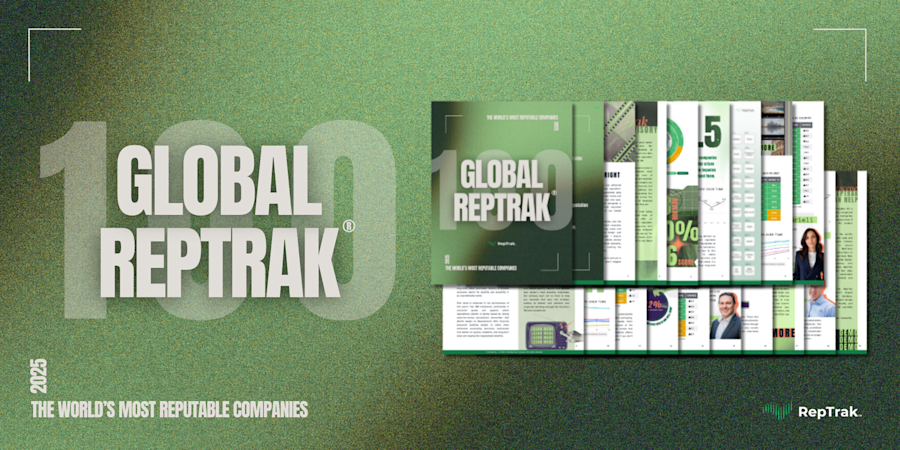Brand and Reputation Are Not the Same
Blog Post16 Aug, 2019
In a recent interview with the American Marketing Association, our CEO Kylie Wright-Ford said it most eloquently:
“Brand is the promise you make; your reputation depends on whether or not you keep that promise."
The MIT Sloan Management Review explains that many executives talk about corporate reputation and brand as if they are one in the same, concluding that “they are not, and confusing the two can lead to costly mistakes.”
Regardless of how brand or reputation are defined, doing the right thing will help all businesses flourish. With this in mind, let’s explore the differentiators, nuances, and how brand and reputation complement one another.
CMOs say they’re not reputation ready
In a climate where a disgruntled customer can live-tweet their disappointment to the world, it’s more crucial than ever for companies to be proactive, not reactive, to threats to their reputation.
For those threats can do real damage to a company's bottom line. Our data shows that the most reputable businesses outperform the financial markets. In fact, a one-point increase in reputation score yields a 2.1% increase in market cap (about 882 million). For a typical company, that translates into $1 billion per reputation point.
Reputation management is also about identifying opportunities for growth. A good reputation, for instance, makes it easier to compete in a crowded marketplace.
“If your reputation is good, you will capture more share of wallet and share of market; if not, then the reverse is true,” says Philip Wang, Senior Vice President for Integrated Brand Marketing at Wells Fargo.
In a survey of Chief Marketing Officers conducted in partnership with The CMO Club, we discovered that nearly 60% of CMOs said reputation was an opportunity for competitive differentiation. Many, however, said they didn’t feel ready to manage their company’s reputation yet. That makes sense, as marketing typically manages a company’s brand, not their reputation.
Brand and reputation are not the same
Our stance on the matter, in case you haven’t guessed, is that brand and reputation are not the same, and conflating the two carries real risks for the long-term health of your business. Rather than being the same thing, brand and reputation are inextricably linked. Your brand can help enhance your reputation; a poor reputation, however, can ruin a brand a company spent decades—even centuries—building.
Brand is developed from the inside out; reputation from the outside in
In the simplest terms, brand is how a company presents itself to its customers, employees, and the public. A well-cultivated brand is a public representation of a company’s core values.
Members of senior leadership have more control over brand; it comes out of the products a company sells, the stores they sell them in, and the well-executed commercials, social media posts, and print ads they use to raise awareness of what their company is and what it represents.
Reputation, on the other hand, is often built far away from the boardroom: It’s cultivated through news reports, word of mouth, and online chatter. It’s about how the public perceives your company, and whether—and to what extent—the public feels you’ve lived up to the promise of your brand. A company can influence its reputation; it cannot create (or re-create it) like it can its brand.
“Your brand is the name you have on the front of the shop. Your reputation is what everyone thinks of it,” says Muriel Lotto, the Global Head of Brand and Marketing at Western Union. “The goal is to bring both together so that when we talk about reputation, brand is a very strong part of it.”
To be clear, branding should play a role in shaping reputation, at least at the beginning. An advertisement—whether in a magazine, on TV, or on Facebook—is usually the first time a potential customer will encounter a given company out in the world.
But consumers don’t live in a bubble and eventually other perspectives—from their neighbors, the media, or even a direct competitor—will permeate.
That’s where reputation management comes in—it helps executives identify and mitigate reputational risk as well as seek out possible opportunities. You can’t really know what you have—and what you need to look out for—until you’ve measured it.
Branding is the theory, reputation is the practice. Brand is the promise, reputation is the follow-through on keeping that promise.
“Reputation is truly based on a company’s ability to deliver on its brand promise and purpose,” says Tanika Vital-Pringle, Chief Marketing Officer of Brand Rebirth. “In turn, fulfilling that purpose drives trust, loyalty, and sales.”
Another distinction is who owns reputation; unlike branding, it’s not solely the domain of marketing. Rather, almost everyone across the c-suite has a role to play in managing and cultivating a company’s reputation.
“It’s a shared responsibility that includes all of our senior leaders and not just the ‘keeper’ of our brand,” says Philip Wang of Wells Fargo.
At Western Union, the ultimate responsibility is with the CEO. At other companies, the Chief Communications Officer is the “keeper” of reputation.
There are many companies that deem reputation a regularly reported on key performance indicator. Employees enterprise-wide at telecom giant Telefonica, for example, are encouraged to achieve non-financial KPIs that include energy efficiency, diversity, and reputation.
Brand is the icing, reputation is the cake.
Here's an example that demonstrates the difference between brand and reputation: Ten years ago, Domino’s Pizza was in a less than stellar reputation situation. Known for poor quality and even worse service, it had limited growth and a stock price stuck below $10. Its brand, like its product was cheap; its reputation was abysmal. The company’s main sell was that it was exceptionally inexpensive and readily available.
New CEO Patrick Doyle didn’t try to paper over these problems with slick advertising or a new marketing campaign; instead, he first set out working on solutions. As outlined in this Harvard Business Review Case Study, he invested seriously in technology, making it easier for customers to order via an app or even by text.
He also re-thought the product itself; focus groups and social media postings complained about the quality of Domino’s crust and the freshness of its ingredients. So Doyle threw out the old recipes and started again. As a show of commitment to making authentic pizza, he even opened a Domino’s location in Italy.
Only after he had done all this work behind the scenes, with serious investments in the products and the stores, did he turn to the marketing department. (After all, the marketing department doesn’t write the recipes or source the ingredients.) The result was a now-famous ad where Doyle and other Domino’s employees apologized for the quality of the pizza and promised to be better.
It was a risk, but a risk that paid off for Domino’s. It’s now the largest pizza chain in the world, with a stock price of more than $280 a share.
With its sleek, modern stores and expanding menu, Domino’s has reinvented its signature product and revitalized its ailing brand.
It did so by taking a cold, hard look at its reputation and by re-thinking processes throughout the company.
Talk the talk only once you've walked the walk
The Domino’s Pizza ad was the culmination of years of work to improve the company. Other attempts to rehabilitate a company’s reputation through an “apology” ad have been less successful.
“A company can lose its reputation very quickly, but can only gain it back slowly in drips,” says Wells Fargo’s Philip Wang.
Wells Fargo knows this better than anyone: It attempted a mea culpa advertisement in 2018, with mixed results. So have Facebook, Uber, and, most recently, Volkswagen.
Part of the problem with many of these ads is that they seem like attempts to airbrush away these companies’ mistakes, rather than genuinely make amends for the wrongs they committed. Volkswagen’s ad, with its dark colors and sad Simon & Garfunkel soundtrack, seems to present the emissions scandals as something that happened to the company, rather than a crisis entirely of its own making.
However, the company is making a strong attempt at transparency. It’s focusing on innovation while attempting to re-establish an emotional connection with the general public — all positive things. Time will tell if the ad (and the campaign) results in a reputational uptick for Volkswagon. Domino’s success shows us that it is accountability along with concrete steps to improve and prevent future issues that appeals to customers. It’s about doing the hard work of improving your reputation, rather than paying mere lip service to change and reform.
It's easy to make a promise; it's much harder to keep it
That, in the end, is the real difference between brand and reputation. One is what you want to be, what you aspire to be. The other is a reflection of who you are, and how others perceive you.
In an ideal world, brand and reputation would be perfectly in sync; companies would always deliver on their promises and customers would feel satisfied and valued.
In reality, many of the best companies in the world still come up a little short. But reputation management can help bridge the gap between what you’re promising and what you’re delivering.
Here's how marketers can define, own, and measure reputation in order to build their brand.
Melanie LoBue Senior Director of Global Marketing The RepTrak Company [email protected] @melanielobue





